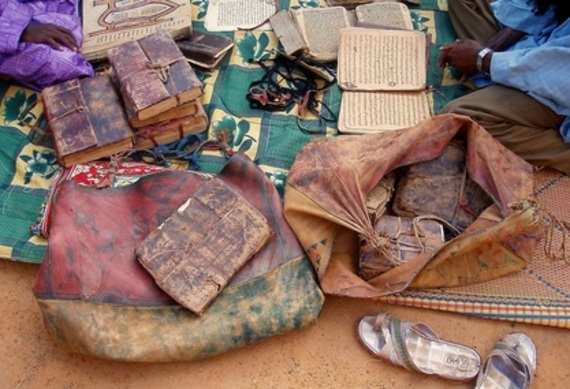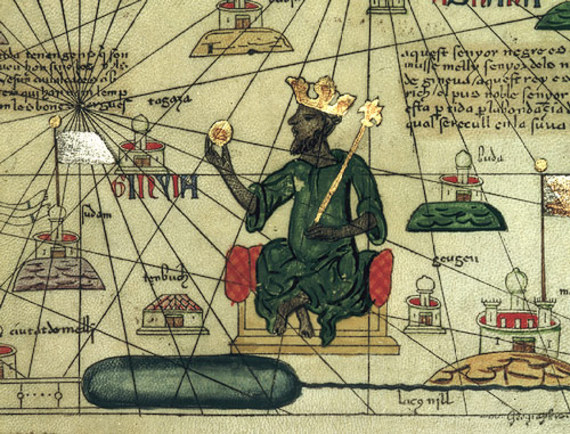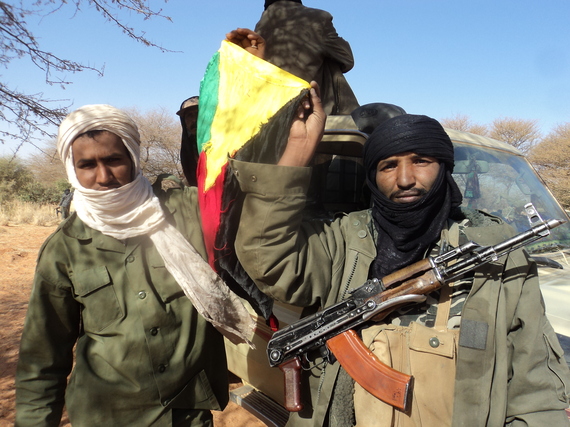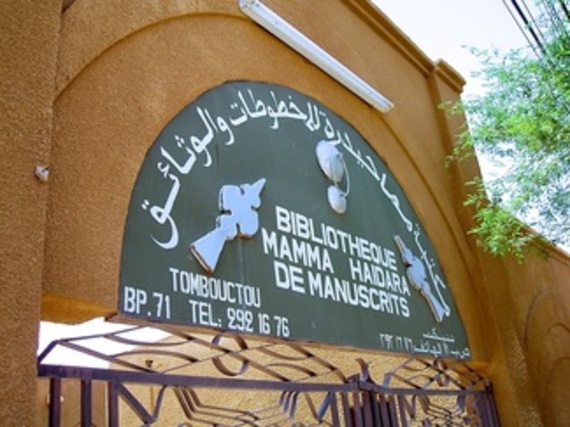For centuries, Timbuktu provided rest alongside the Niger River for travelers journeying across the African Continent. From the 12th through the 16th Centuries, Mali became an intellectual haven for Islamic scholars. The manuscripts produced during that time have survived centuries of unprotected storage in Timbuktu, and only recently came to the attention of the world community.
Michael Covitt was one of the first to recognize the value of these documents, not only as historical artifacts, but also as true Islamic manuscripts professing peaceful resolution of conflict and a world of tolerance, understanding and the dignity of mankind.
Through his passion and determination, he led the way in increasing awareness of the documents around the world, digitizing the manuscripts for scholars to study, and preserving the original documents in a proper, climate controlled environment. His documentary film, '333,' is a superb film about the region, the manuscripts, and the message of peace.
In a time when the teachings of Islam are being perverted and conflict appears to be the preferred action for many extremists, the Malian Manuscripts provide a better solution for mankind. Thank you, Malian Manuscript Foundation, for taking the lead in preserving, promoting, and educating the world about these treasures.
The preceding passage is from a page of quotes on the Malian Manuscript Foundation Website. It was authored by Gen. Carlton W. Fulford, Jr., a retired United States Marine Corps four-star general who served as Director of the Africa Center for Strategic Studies, Deputy Commander in Chief of the United States European Command and Director of The Joint Staff. Earlier, he led Marine operations in Desert Storm and Desert Shield. This is one of many such accolades about the project to save the Malian Documents that are reproduced on the Malian Manuscripts Foundation website, here.
Approximately 800 years ago, Mansa Musa, a legendary African monarch with incomparable wealth, was King of Mali. At the time, Mali was the world's wealthiest nation, controlling two-thirds of the earth's gold supply. In 1324, King Musa made a pilgrimage to Mecca, attended by 60,000 men including 12,000 slaves, each carrying four-pound gold bars. They also boasted heralds dressed in silks, brandishing gold staffs four meters long, countless horses, plus eighty camels, each carrying between fifty and three hundred pounds of gold dust.
In the course of his pilgrimage to Mecca, the King donated so much gold to the needy that the Mediterranean gold market collapsed. His primary objective, however, was to worship at the most sacred shrine of Islam, the Kaaba, and then to return to Mali bringing with him as many religious scholars as possible in order to create a new center for Islamic scholarship in Timbuktu. He established, what was for his time, one of the world's most prestigious universities. A total of 180 different Koranic schools were organized under the authority of the University of Sankoré.
From the 12th through the 16th Centuries 25,000 students from throughout the Islamic world annually attended this distinguished university in Timbuktu. Having received the best education available, many scholars settled in Mali, contributing their own manuscripts to the vast library taking form. Nearly one million manuscripts in all, covering every imaginable topic, would eventually find a home there. The scholars were among the foremost experts of their time in anthropology, architecture, biology, chemistry, geography, history and medicine; they were authorities on Islamic jurisprudence, government, mathematics, music and mysticism.
They wrote on such 21st century topics as children's and women's rights, the rights of animals and the obligations of their keepers towards them. They also produced a vast library of religious scholarship. Most importantly, they devised a remarkably enlightened strategy for the peaceful resolution of conflict through dialogue, tolerance, understanding and forgiveness; a strategy as relevant today as it was in 14th century Saharan Africa. This doctrine is in sharp contrast to the intolerant violent Jihadism prevalent in North Africa and the Middle East today.
Knowledge from the manuscripts has been passed down from one generation to the next for centuries. If your parents were scholars, you were expected to be a scholar. For almost a thousand years, Islamic scholars who reached the pinnacle of learning as "Ambassadors of Peace" have sat daily before sunrise in an assembly called the "Circle of Knowledge," instructing devotees with lessons and insights derived from these ancient manuscripts.
The path to "Ambassadorship" is incomprehensibly demanding. Before reaching the age of five, each student must become an apprentice and pledge to study under the tutelage of the same teacher. The apprenticeship is a process lasting 35 years. By the age of ten, students are able to converse in several languages and must be able to recite the Koran from memory. Prior to turning 40, every apprentice must have mastered Islamic jurisprudence in addition to his own chosen field of study. At that point, each candidate goes out into the streets as a beggar, to instill humility. Then, if they demonstrate that they are totally devoted to God, they become "Ambassadors of Peace."
I first learned about Mali, its manuscripts, and the Malian Manuscript Foundation (MMF) from Mr. Michael Covitt, the MMF's founder.
The latest chapter in the remarkable story of the Malian manuscripts began with an insurgency led by the group MNLA, (National Movement for the Liberation of Azawad). Azawad, a territory in northern Mali, is part of a narrow, desolate strip where the Sahara desert gives way to the arid Sahel. Azawad's terrain, roughly the size of Texas, has few structures or communities. In fact, it is mostly sand. Azawad's most famous city, Timbuktu, was -- before the advent of ocean borne commerce -- at the center of a vast network of international trade routes that crisscrossed the Sahara desert.
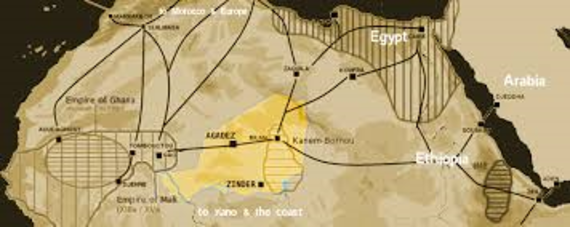 Timbuktu and North Africa's Ancient Trade Routes The MLNA was originally a band of young Tuareg nomads living in Mali's north. Desperately poor, their families subsisted on about a dollar a day. Determined to have a better life, these young men travelled to Libya and found employment with the Libyan military. In the course of their training, they learned to drive vehicles, how to shoot and ultimately how to kill.
Timbuktu and North Africa's Ancient Trade Routes The MLNA was originally a band of young Tuareg nomads living in Mali's north. Desperately poor, their families subsisted on about a dollar a day. Determined to have a better life, these young men travelled to Libya and found employment with the Libyan military. In the course of their training, they learned to drive vehicles, how to shoot and ultimately how to kill.
When Libya's dictator Col. Muammar Gaddafi was killed in the Battle of Sirte on October 20, 2011, the young Tuareg who had been employed as his mercenaries, plundered Gaddafi's stockpile of armaments and ammunition, including surface to air missiles. Five different times, they loaded seventeen hijacked trucks with their spoils, and drove the one thousand mile journey across three different nations to northern Mali. The MNLA was born from that Libyan largess. With firepower to spare, they joined with AQIM (Al-Qaeda in the Islamic Maghreb). Formerly based in Algeria this Al-Qaeda affiliate has since expanded throughout northwest Africa. Together with another radical Islamic group, Ansar Dine (Defenders of the Faith), they repeatedly crushed the larger 6,000 strong, U.S. Special Forces trained, Malian military. Despite being outnumbered, these radical combatants hammered the more sizeable Malian forces in every single battle.
According to Michael Covitt, "It's not that the rebels had a better fighting force, but they were better armed. Mali's President, Amadou Toumani Touré, the prime mover of Malian democracy and a senior African statesman did not want to enable the killing of his own people, so he made sure that his military was not amply fortified."
On March 21, 2012, just weeks before his scheduled retirement, Touré's failure to adequately arm his troops triggered a military coup d'état led by the then 39-year-old Captain Amadou Sanogo. He was a low-level military officer who had received some limited U.S. military training. To avoid the risk of capture or physical harm, President Touré and his family fled Mali for neighboring Senegal.
Over the weekend of March 30- April 1, the radicals seized the three capital cities of the north - Kidal, Gao, and Timbuktu. Despite strict orders from Al-Qaeda to stand down, Ansar Dine planted their white-centered-circle-on-black Salafist flag (the same flag brandished by ISIS and Boko Haram), over Timbuktu's historic center and immediately imposed Sharia law.
Ansar Dine's ruthless regime ultimately led to war amongst the insurgents. The "War of Gao" -- on June 26th and 27th, 2012, was fought by the MNLA against MOJWA (Movement for Oneness and Jihad in West Africa), another radical Islamic Group, and Ansar Dine. MNLA was soon defeated and immediately withdrew into the desert. On the heels of the military coup, Mali's military began looting areas under their control. This prompted the jihadists who now controlled Azawad, to dispatch their troops southward towards Bamako, the Capital of Mali. Meanwhile, Ansar Dine had bulldozed various UNESCO World Heritage Sites in Timbuktu, including the grave sites of various Sufi saints. Before its descent into chaos, Mali had been considered one of the most stable democracies in North Africa.
The chaos in Mali threatened to spill over into adjoining regions of North Africa, prompting French president Francois Hollande to order the French Foreign Legion to enter Mali and restore order in the former French colony. The French intervention was launched in January 2013, and opened with the bombing of Mali's insurgents. Outnumbered, out-armed, and outfought by the French legionnaires, the jihadists retreated to a warren of vast tunnels which they had previously burrowed beneath the Sahara sands and stocked with food, water, vehicles, and gasoline. Prior to their withdrawal however, in retaliation for France's intervention, Ansar Dine destroyed 4,000 of Mali's ancient manuscripts in a blaze of fire.
Timbuktu is widely-known as the City of 333 Saints, so-named for the Sufi Saints buried there. Sufism is a branch of Islam noted for its commitment to peaceful resolution of conflict. But nothing is more precious to Mali's people, and to the rest of the world, than Mali's ancient manuscripts. So the wanton destruction of these irreplaceable documents was a devastating blow not only to Islamic scholarship but to scholars everywhere.
Approximately 80,000 ancient manuscripts were reportedly housed in Timbuktu's official libraries, of which twenty thousand had been catalogued. Most of the remaining manuscripts are in small, private, family-owned libraries. Many manuscripts have not yet been discovered, much less cataloged. It is estimated that there are over a million manuscripts hidden away in Timbuktu and the surrounding region. Many are " under lock and key, or concealed beneath the Sahara, or out of sight in secret places, " explained Mr. Covitt.
Abdel Kader Haidara, a respected librarian featured in the film "333," devised a plan to save Timbuktu's remaining manuscripts, and raised roughly $1 million from the Ford Foundation, the German and Dutch governments, and an Islamic center in Dubai to collect and preserve these documents.
Photo by David West for Malian Manuscript Foundation
French President Holland reduced then ultimately withdrew the three-thousand Legionnaires sent to Mali. They were replaced by a United Nations peacekeeping force of approximately twelve-thousand troops from various countries. Many of these UN troops, poorly armed, were later slain by the jihadists.
The defeat of the rebels combined with a "financial sweetener" from ECOWAS, prompted Capt. Sonogo to step down, transferring his power to Dioncounda Traoré in April, 2012. Traoré was slated to serve as Interim President for thirty days. But when Traoré didn't vacate the presidency as scheduled, the Presidential Palace was stormed by soldiers loyal to Sonogo. Traoré was severely beaten and had to be evacuated to Paris for hospitalization. Despite this travail, Traoré returned to Mali and extended his role as Interim President until September 4, 2013. During his tenure, Traoré persuaded the European Union to earmark roughly $2 billion for the rebuilding of Mali's infrastructure.
On the day of Traoré's retirement, Ibrahim Boubacar Keita, who had earlier been elected President, became Mali's new leader. Shortly thereafter, in a series of Machiavellian maneuvers, Keita first promoted former coup leader Captain Sonogo to General, then jailed his loyalists, and finally imprisoned Sonogo.
Owing to Mali's civil war, nearly 500,000 Malians were displaced from their homeland during the fighting, including most of the people appearing in the film 333. However, the Malians followed the ancient teachings set out in their historic manuscripts and applied Mali's centuries-old tradition of peacefully resolving conflict through dialogue to end the fighting. On Saturday, June 20, 2015, the various parties gathered at last, to sign a peace accord to end the years of fighting between them. This was a poignant example that Islam can be a religion of peace and understanding and not just one of violent jihad.
To see Sabatier Film Group's fascinating 333 trailer about the manuscripts and "Ambassadors of Peace", visit: here.

